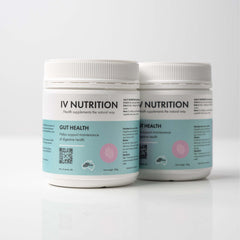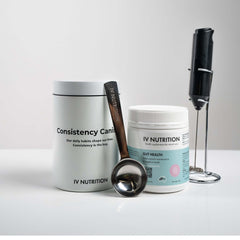Gaining Belly Fat? Here’s What You Should Know...
You wake up, look in the mirror, and notice that your midsection feels tighter — maybe your jeans are rebelling too. Belly fat sneaks up on many of us, especially as we age, and contrary to popular belief, it’s not just about eating too much or exercising too little. There’s a lot more going on beneath the surface.
From shifting hormones and stress to gut health and food choices, abdominal fat is influenced by complex biological systems. And if you’ve been wondering why your belly’s growing despite doing "all the right things," this article is for you.
Let’s unpack the real science behind belly fat, why it matters for more than aesthetics, and what you can do today to take back control — without giving up every carb in sight.
What Is Belly Fat, Really?
Visceral vs. Subcutaneous Fat
There are two types of belly fat:
-
Subcutaneous fat: This sits just under the skin. It’s the soft, pinchable kind.
-
Visceral fat: This is the dangerous stuff. It wraps around your internal organs and is linked to a higher risk of heart disease, insulin resistance, and even dementia.
According to Harvard Medical School, visceral fat is especially problematic because it's metabolically active. It pumps out inflammatory chemicals like cytokines and increases the risk of metabolic syndrome — a cluster of conditions that includes high blood pressure, high blood sugar, and abnormal cholesterol levels.
Why Am I Gaining Belly Fat?
1. Aging and Hormonal Shifts
As we age, our hormones shift dramatically. In women, declining estrogen during perimenopause and menopause redistributes fat from the hips and thighs to the abdomen. For men, falling testosterone levels can have a similar effect.
Research published in the Journal of Clinical Endocrinology & Metabolism shows that low sex hormone levels are directly correlated with increased visceral fat accumulation in both men and women.
2. Poor Sleep
Lack of quality sleep (less than 7 hours a night) triggers cortisol production and disrupts appetite-regulating hormones like leptin and ghrelin. Studies such as this one from Sleep show that people who sleep less are more likely to store fat centrally.
3. Chronic Stress
Stress doesn’t just make you feel overwhelmed — it also alters your body’s biochemistry. Elevated cortisol levels, your primary stress hormone, increase fat deposition in the abdominal area. The more stress you carry, the more likely you are to gain visceral fat.
4. Gut Dysbiosis
Yes, your belly fat may have a bacterial component. A disrupted gut microbiome — also known as gut dysbiosis — has been linked to metabolic disease and abdominal obesity. According to a study in Nature, obese individuals tend to have less microbial diversity and fewer beneficial bacteria.
Belly Fat & Health: What’s At Stake?
If you’re gaining belly fat, it’s more than a cosmetic concern. Here’s what the research tells us about its impact:
| Health Risk | Description | Supporting Source |
|---|---|---|
| Type 2 Diabetes | Visceral fat releases free fatty acids that increase insulin resistance. | Mayo Clinic |
| Heart Disease | Abdominal fat is linked to high LDL cholesterol and hypertension. | American Heart Association |
| Fatty Liver Disease | Excess belly fat can lead to non-alcoholic fatty liver. | Cleveland Clinic |
| Cognitive Decline | Visceral fat increases brain inflammation and risk of dementia. | Journal of Alzheimer's Disease |
What Can You Do About It?
Thankfully, belly fat isn’t permanent — and you don’t need a juice cleanse or extreme dieting to tackle it. Here's what works, based on clinical science.
1. Prioritize Whole Foods Over Calories
You’ve probably heard “calories in, calories out” as the holy grail of fat loss. While calorie balance does matter, quality is just as important as quantity.
Foods high in refined carbs (white bread, sugary drinks) spike insulin and increase visceral fat. Instead, focus on:
-
Leafy greens
-
Healthy fats (avocados, olive oil)
-
Whole grains
-
Lean proteins
-
Fermented foods (kimchi, yogurt)
A study published in The Lancet showed that diets rich in high-fiber whole foods were significantly more effective for long-term fat loss than low-fat or low-carb diets.
2. Exercise Smart — Especially Resistance Training
Moderate-intensity cardio helps burn calories, but strength training is your real ally against belly fat.
A 12-month study in obesity found that resistance training was more effective at reducing visceral fat compared to aerobic training alone.
Aim for at least:
-
2–3 sessions/week of resistance training
-
150+ minutes of weekly moderate cardio
3. Improve Your Gut Health with Prebiotics
Here’s where things get interesting: gut health is a powerful, and often overlooked, regulator of belly fat.
Prebiotic fibers feed your beneficial gut bacteria — the ones that help regulate inflammation, balance hormones, and control blood sugar. They’re different from probiotics, which are actual live organisms. Prebiotics are the fuel for these bacteria to thrive.
And one standout product to consider is the Virgin Manufactured Sugarcane Prebiotic Fiber from IV Nutrition.
Not only is it:
-
Plant-based
-
Gut-nourishing
-
Free of artificial additives
But IV Nutrition is currently offering 100% off your first tub when you subscribe. It’s a clinically-supported way to improve digestion and help manage body fat — naturally. Claim your first tub free here.
The Science Behind Prebiotics & Belly Fat
A 2021 study in the Journal of Nutrition showed that individuals supplementing with prebiotic fiber saw significant reductions in visceral fat over 12 weeks. The mechanism? Improved insulin sensitivity and reduced inflammation.
Another clinical review in Frontiers in Endocrinology explained how gut microbial diversity impacts fat storage, and how prebiotic supplementation helps reverse this process.
4. Get 7–8 Hours of Sleep — Seriously
Short sleepers tend to store more abdominal fat. Why? Because poor sleep increases cortisol and ghrelin, both of which signal your body to hold onto fat. Even just two consecutive nights of less than 6 hours can spike cortisol and reduce glucose tolerance.
Need help sleeping better? Try:
-
No screens 1 hour before bed
-
10-minute nightly wind-down routine (like stretching or journaling)
-
Magnesium-rich foods (almonds, spinach)
5. Reduce Stress Without Quitting Life
You don’t need to become a monk to manage stress. Just a few small changes can lower cortisol and help you drop stubborn fat.
Try:
-
Box breathing (inhale 4 sec, hold 4, exhale 4, hold 4)
-
10-minute walk breaks
-
Journaling three things you’re grateful for
Fun fact: Laughter literally reduces cortisol. Time to bring back your favorite comedy playlist.
Debunking 3 Common Myths About Belly Fat
Myth 1: "I can crunch my belly fat away."
Nope. You can’t spot-reduce fat. Crunches strengthen abdominal muscles, but they don’t shrink the fat above them. You need a mix of strength, cardio, and diet.
Myth 2: "I’m gaining weight because I’m eating carbs."
Not all carbs are bad. Complex carbs like quinoa, oats, and sweet potatoes actually support fat loss because they stabilize blood sugar and support healthy gut bacteria.
Myth 3: "Belly fat is just cosmetic."
We’ve said it before, and we’ll say it again — visceral fat is biologically active and can harm your heart, brain, and liver. It’s not just about the mirror.
A Sample Belly-Fat-Fighting Daily Routine
| Time | Activity | Why It Helps |
|---|---|---|
| 7:00 AM | Wake, hydrate, light walk | Boosts metabolism & cortisol balance |
| 8:00 AM | Protein + prebiotic fiber breakfast (e.g., eggs + IV Nutrition scoop in smoothie) | Balances blood sugar & feeds gut bacteria |
| 12:00 PM | Salad with greens, avocado, lean protein | Anti-inflammatory, fiber-rich |
| 5:30 PM | Resistance workout | Increases muscle & fat-burning hormones |
| 7:00 PM | Complex carb dinner + probiotic food (e.g., brown rice & kimchi) | Supports digestion, recovery |
| 9:00 PM | Light stretching & magnesium tea | Improves sleep & cortisol regulation |
Final Thoughts: You’re Not Failing — Your Biology Is Just Doing Its Job
If you're gaining belly fat, don’t beat yourself up. It's not just about willpower — it’s about working with your body, not against it.
By focusing on science-backed strategies like nourishing your gut, getting better sleep, managing stress, and feeding your body quality food (not just fewer calories), you’ll not only slim your waistline — you'll improve your whole-body health.
And don’t forget to give your microbiome the fuel it needs. If you want a simple, powerful tool to help flatten your belly from the inside out, grab your first tub of Virgin Manufactured Sugarcane Prebiotic Fiber from IV Nutrition FREE when you subscribe. Click here to get the offer.
Your gut will thank you — and so will your jeans.





